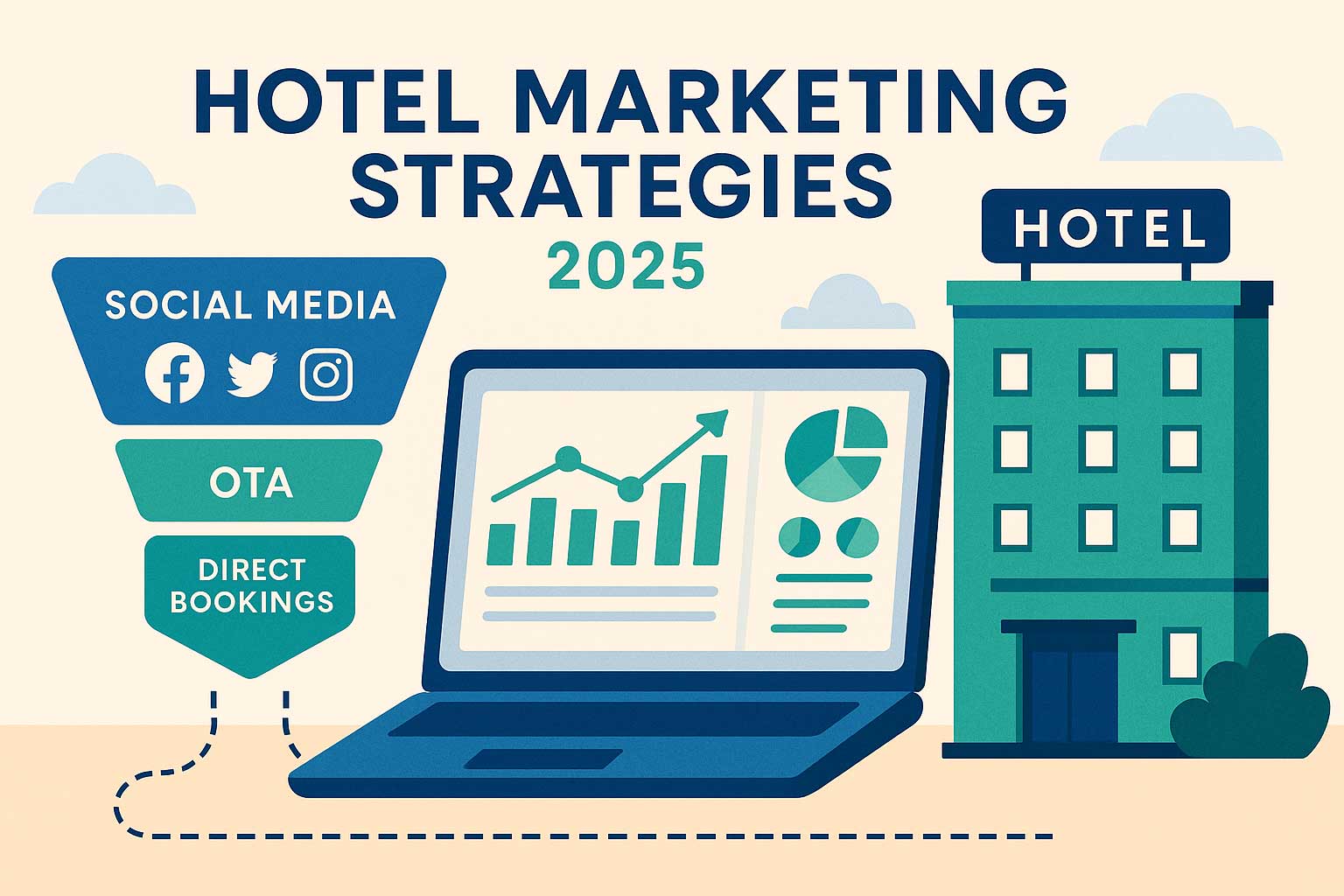What is Flow Through in Hotels: Guide to Hotel Profit Management
Sep 15, 2025
 Mika Takahashi
Mika TakahashiPopular Categories
Hotel Technology & InnovationHotel Operations OptimizationDigital MarketingIndustry TrendsRevenue ManagementHospitality Industry
Popular Categories
Trending Post

Hotel Walk Letter Template: Professional Guest Communication

Online Travel Agents: What They Are and How They Work

Hotel Security Systems: Modern Protection Solutions

Hotel Advertising: Complete Guide to Boost Bookings and Revenue

25 Hotel Marketing Strategy Ideas for 2025: Complete Guide

AI Reservation Agent: Revolutionizing Hotel Booking and Guest Experience

PMS Communication: Streamlining Property Management Through Effective Guest Messaging
Table of contents
Hotel managers often celebrate when revenue goes up, but the real question is: how much of that extra revenue actually turns into profit? That’s where understanding flow through becomes a game-changer for any hotel looking to boost profitability beyond just bringing in more money.
This guide will walk you through everything you need to know about flow through—from the basics of how to calculate it to smart strategies for improving your hotel’s financial health.

Flow Through Definition and Core Concept
Simply put, flow through measures the percentage of extra hotel revenue that actually makes its way into hotel gross operating profit (GOP). It’s a key metric that shows how well a hotel turns additional revenue into real profit, especially when actual revenue beats the budgeted numbers.
Also called the “retention rate,” flow through tells you how much of that extra income “flows through” to your bottom line after covering the additional costs that come with more business. For hotel owners and managers, this insight is invaluable—it goes beyond just looking at revenue growth and helps you see the true profitability picture.
This concept is especially important when assessing revenue management efforts. You might raise your room rates and see gross revenue climb, but if your operating costs rise just as fast—or faster—that extra revenue won’t boost your profit much. Flow through helps you understand if increased revenue really translates into financial gain.
Flow through applies to all the revenue streams your hotel has—from room revenue and food and beverage sales to outlet sales and other services. Knowing how each department contributes to profit flow helps you make smarter decisions about where to focus your efforts.
How to Calculate Flow Through
Calculating flow through is straightforward: subtract budgeted GOP from actual GOP, then divide by the difference between actual revenue and budgeted revenue, and multiply by 100 to get a percentage.
For example, if your hotel brings in $40,000 more revenue than budgeted, and your gross operating profit rises by $24,000 over the budgeted profit, your flow through is ($24,000 ÷ $40,000) × 100 = 60%.
You can calculate flow through for your entire hotel or break it down by departments like rooms, food and beverage, or other revenue sources. The key is to use consistent data from comparable periods to get meaningful insights.
Step-by-Step Calculation Process
Start by gathering actual revenue and GOP data for the current period from your property management system or accounting software to ensure accuracy.
Next, compare these actual figures with your budgeted revenue and GOP targets for the same timeframe. Remember, budgeted revenue should be your original forecast, not any updated projections made during the period.
Calculate the incremental revenue by subtracting budgeted revenue from actual revenue. For instance, if actual revenue is $500,000 and budgeted revenue is $460,000, your incremental revenue is $40,000.
Then, find the incremental profit by subtracting budgeted profit from actual profit. If actual GOP is $180,000 and budgeted GOP is $156,000, your incremental profit is $24,000.
Finally, divide the incremental profit by incremental revenue and multiply by 100 to get your flow through percentage: ($24,000 ÷ $40,000) × 100 = 60%.

Industry Benchmarks and Standards
Typically, hotel flow through falls between 35% and 60%, depending on the type of property and market conditions. These benchmarks give you a helpful reference point to see how your hotel stacks up and where you might improve.
Rooms departments usually enjoy higher flow through rates—between 60% and 75%—because the variable costs linked to additional room revenue are relatively low. Once you cover fixed costs like housekeeping and utilities, extra room revenue tends to flow more directly to profit.
On the other hand, food and beverage departments often see flow through rates between 35% and 50%, since hotel variable costs like ingredients, beverages, and service staff increase with each sale.
Luxury hotels may show higher flow through percentages after their fixed costs are covered, thanks to higher profit margins on incremental revenue. Smaller boutique hotels might have lower flow through due to higher proportional operating costs, as they have fewer rooms to spread those fixed expenses across.
Positive vs Negative Flow Through
Positive flow through means you’re effectively controlling costs and turning extra revenue into real profit. When you see positive flow through, it means your management team is doing a great job capturing incremental profit from additional revenue.
Flow through rates between 50% and 90% are considered excellent, showing strong cost control and profit conversion.
Negative flow through happens when costs rise faster than revenue, hurting your bottom line. For example, a flow through of -25% means you’re losing 25 cents in profit for every extra dollar earned—a clear sign of operational trouble.
Recognizing negative flow through helps you spot when revenue growth might actually be costing you money. This can happen if you take on low-margin business or fail to manage costs well during busy times.
Understanding Flex Ratios
Flex ratios come into play when actual revenue falls short of budget expectations. They measure how well you reduce costs in response to declining revenue. Flex is basically the opposite of flow through during revenue drops.
Industry average flex ratios usually range from 30% to 35%, lower than flow through rates because it’s harder to cut costs quickly when revenue falls, especially with fixed expenses and labor contracts.
A positive flex ratio means you’re successfully cutting costs to protect profits during slow periods. Hotels with good flex can adjust variable expenses to match lower occupancy, helping maintain profitability even when demand drops.
Being able to manage both flow through and flex ratios shows that your hotel is financially nimble and well-run, no matter the market conditions.
Why Flow Through Matters for Hotel Success
Flow through gives you a clearer picture of operational efficiency beyond just occupancy and average daily rate (ADR). While those traditional metrics show volume, flow through reveals how that volume impacts your actual profits.
It helps pinpoint which revenue strategies genuinely improve your bottom line and which just boost top-line numbers without adding profit.
Flow through also guides pricing decisions by showing how rate changes affect profit flow, helping you optimize revenue management beyond simple demand forecasting.
This metric is vital for realistic budget planning and forecasting. By studying past flow through patterns, you can better predict how revenue changes will affect your profit.
For investors and stakeholders, flow through demonstrates your ability to turn revenue growth into real profit, building confidence in your management.
Departmental Flow Through Analysis
Rooms revenue usually has the highest flow through because variable costs per occupied room are low. Once fixed costs like housekeeping and utilities are covered, extra room revenue converts efficiently to profit.
Food and beverage operations tend to have lower flow through because of labor, food, and service costs. Every extra meal or drink sold requires more staffing and inventory.
Spa, recreational services, and conference revenue flow through varies depending on staffing and service needs. Some spa services have high margins; others require more labor investment. Events using existing spaces with minimal catering often have better flow through than those needing extensive setup.
Understanding these departmental differences helps you focus on high-flow-through revenue streams while improving efficiency in lower-performing areas.

Common Flow Through Challenges
Rising labor costs can eat into flow through, even when revenue is strong. When wages rise faster than room rates, extra revenue can get swallowed up by staffing expenses.
Utility bills that increase faster than occupancy growth also reduce profit conversion. Energy, water, and other utilities might scale disproportionately with guest volume, impacting flow through.
Overstaffing during busy periods can create unnecessary costs, weakening flow through. Adding staff in anticipation of demand without optimizing schedules can hurt profitability.
Extra amenity costs and guest service expenses can chip away at incremental profit. Complimentary perks or enhanced housekeeping may reduce the profit impact of higher room revenue.
Technology upgrades and maintenance that don’t scale with revenue can unexpectedly drain profits. Investments need to be balanced against their effect on flow through.
Strategies to Improve Flow Through Performance
Use real-time expense monitoring to track variable costs alongside occupancy. This helps catch rising costs early so you can act before profits suffer.
Leverage property management systems to optimize staffing based on demand forecasts. Smart scheduling aligns labor costs with revenue, avoiding overspending.
Create flexible cost structures that adjust quickly with occupancy changes. Variable contracts and flexible staffing help you respond to business fluctuations.
Focus on high-margin revenue streams and upselling to boost overall flow through. Prioritize services and amenities that bring the best profit flow.
Regularly analyze departmental flow through to spot opportunities for improvement. Monthly or quarterly reviews can reveal trends and areas needing attention.
Technology Tools for Flow Through Management
Revenue management systems that combine cost data with pricing help you analyze profit flow comprehensively. These tools support setting rates that maximize flow through, not just revenue.
Expense tracking platforms give real-time views of food costs, labor, and utilities against occupancy and revenue.
Analytics dashboards show flow through trends across periods and market segments, helping identify your most profitable channels and customer groups.
Automated reports comparing actual to budgeted performance daily help spot flow through issues early, so you can fix them quickly.
Integrating PMS, accounting, and operations systems creates seamless flow through monitoring, giving you full visibility into how revenue and costs interact.
Flow Through in Different Market Conditions
In strong markets, flow through tends to be higher because hotels can raise rates without costs rising as much. Additional revenue often comes from rate premiums rather than higher operational complexity.
In weaker markets, careful cost management is key to maintaining positive flow through despite pressure on rates. Efficiency and expense control become critical.
Seasonal changes affect flow through patterns, so management strategies need to adapt throughout the year. Peak seasons may offer high flow through opportunities, while shoulder seasons require tight cost control.
Economic downturns test your ability to maintain flex ratios and protect profits when revenue drops. Flexible cost structures and efficient operations help keep profit flow steady during tough times.
Recovery periods provide chances to improve flow through by managing costs strategically and optimizing pricing as demand returns.

Mastering flow through is one of the most valuable skills for today’s hotel managers. It offers the clearest view of how well your property turns revenue opportunities into real profit gains. By setting up solid tracking, keeping costs flexible, and analyzing departments regularly, you can boost your hotel’s profit flow and overall financial health.
As the hospitality industry evolves, flow through analysis becomes even more crucial. Hotels that understand and use this metric will be better equipped to navigate market shifts, optimize operations, and deliver strong returns to stakeholders. Start tracking flow through at your property today to unlock better profitability and sharper business insights.
